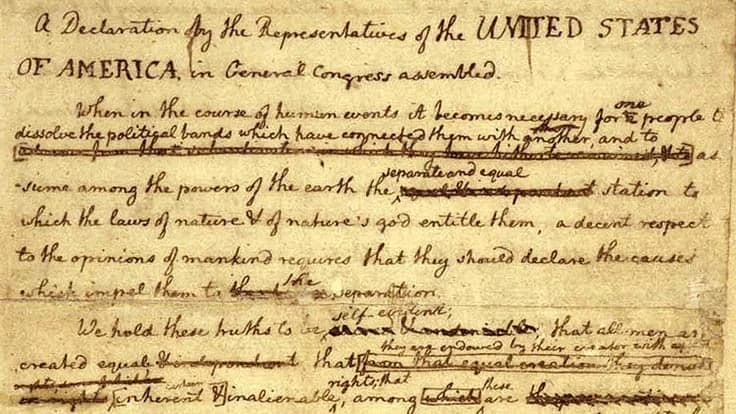
"Taxation without representation!" was the battle cry in America’s 13 Colonies, which were forced to pay taxes to England's King George III despite having no representation in the British Parliament. As dissatisfaction grew, British troops were sent in to quell the early movement toward rebellion. Repeated attempts by the Colonists to resolve the crisis without military conflict proved fruitless.
On June 11, 1776, the Colonies' Second Continental Congress met in Philadelphia and formed a committee whose express purpose was drafting a document that would formally sever their ties with Great Britain. The committee included Thomas Jefferson, Benjamin Franklin, John Adams, Roger Sherman and Robert R. Livingston. Jefferson, who was considered the strongest and most eloquent writer, crafted the original draft document (shown above). A total of 86 changes were made to his draft and the Continental Congress officially adopted the final version on July 4, 1776.
The following day, copies of the Declaration of Independence were distributed, and on July 6, The Pennsylvania Evening Post became the first newspaper to print the extraordinary document. The Declaration of Independence has since become our nation's most cherished symbol of liberty.
Follow this link to read more about The History of America’s Independence Day
Latest from Today's Medical Developments
- CMMC Roll Out: When Do I Need to Comply? webinar
- Metabolic research uses Siemens gas analyzers to deliver results with 99.9999% resolutions
- Mazak’s SYNCREX 38/9 Swiss-type production turning machine
- Current economic and geopolitical realities demand decisive action
- Collaboration to advance pediatric medical technologies
- Guyson's TR-1000 Custom Vertical Blast System
- Intelligent data for the digital factory
- Edge Technologies' latest barfeeders





